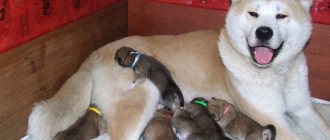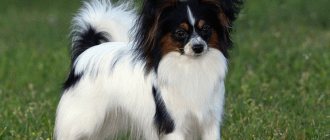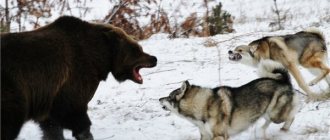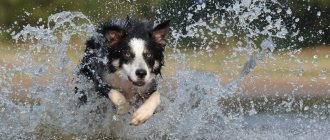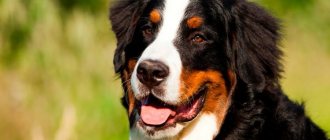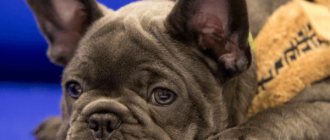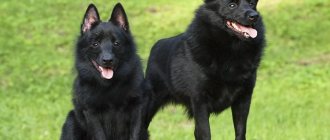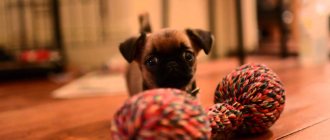Physiological features of puberty
The genital organs of male dogs are a complex system consisting of testes with appendages, vas deferens, accessory gonads and penis. During intrauterine development and in the first few weeks (sometimes days) of a puppy’s life, the testes are located in the abdominal cavity. With the correct formation of the body, by 2–5 months they descend into the scrotum. As a result of certain factors, such as stress, cold or fear, the testes may rise into the pelvic area. This is a normal reaction of the body of a young animal, which should not cause concern to its owner. The male penis has a small bone inside, and along its entire length and closer to the base there are cavernous bodies that swell during arousal. Swelling of the bulbs and corpora cavernosa can be observed even in small puppies, and this is not a pathology.
Puberty in dogs
In addition, early mating has an adverse effect on the growth and development of bitches.
It is also impossible to postpone mating for several years. If a male dog does not mate until the age of 5-6 years, then his sexual activity noticeably decreases, and the quality of sperm deteriorates greatly. Bitches of this age who have not previously bred are less likely than young ones to become pregnant (pregnant) and have a more difficult delivery.
Males and females are allowed to breed up to 8 years of age. In some cases, especially valuable breeding dogs are bred at an older age.
A month before mating, bitches are examined for helminths and, if infected, are dewormed. If the bitch was not examined and dewormed before mating, this must be done 10-12 days after mating. Later deworming is not recommended.
Bitches should be bred once a year, preferably at the end of winter or early spring, so that the puppies grow and develop during the most favorable spring-summer period. It is not recommended to breed a bitch every time and get a litter from her every time. This will adversely affect the dog's health, and the puppies will be weaker.
Mating is carried out in most cases on the 11th - 13th day after the start of estrus. The optimal mating period within the specified period is the day before ovulation (the release of mature eggs from the ovaries). It is difficult to determine the optimal mating period, since the period of ovulation after the onset of estrus in females depends on their individual characteristics, but one must strive for this: mating at the optimal time increases the possibility of fertilization of eggs with sperm. It is also very important to accurately determine and record the first day of the onset of estrus, despite the fact that the bitch often licks her external genitalia during this period. In determining the optimal mating period, careful observation of the behavior of an empty female will help, identifying on this basis the day of her greatest readiness for mating. One of these methods is to place your palm on the area of the bitch’s croup, remembering that the centers of sexual reflexes are located in the spinal cord. Typically, bitches that are ready to breed will arch their backs, move their tails to one side, and show other signs of heat. By the optimal mating time, the bloody mucus (estrus) disappears.
Mating is best done in the morning before feeding the dogs or 3-4 hours after feeding, in an area where there are no strangers, other animals or vehicles (dogs, especially males, should not be distracted by strong irritants). Before mating, the dogs are given a good walk so that they empty the rectum of feces and the bladder of urine; the animals must be given time to rest and get to know each other so that they can look around, sniff, so that they develop mutual sexual attraction. To do this, they are led near each other on leashes, avoiding insufficiently prepared mating and possible biting of the dog by the bitch (some bitches, especially young ones, despite their readiness for mating, bite male dogs). When showing aggressiveness, a muzzle is put on the bitch.
If the dogs have already been mated and have sexual experience, then usually the owner of the bitch, bending or crouching in front of her, holds her by the collar, and the owner of the dog or the instructor brings the dog for mounting. As a rule, the male jumps up on the bitch and, leaning on the ground with his hind legs, grabs and squeezes the bitch in the groin area with his front legs. After one or two attempts, he inserts the penis into the vagina, makes several rhythmic movements and releases the seed deeply. Sometimes this requires several cages.
After repeated unsuccessful mountings, you need to take a 15-20 minute break, during which the dog is taken away and walked. If, during mounting of a male dog, the ejaculation of semen did not occur in the bitch’s vagina, but outside, then a break is taken for 1.5-2 hours, after which mounting is repeated.
If the bitch behaves restlessly, crouches down when mounting the dog, turns out from under him, then her owner, bending or crouching in front of her, firmly holds the dog by the collar with both hands, not allowing her to change her standing position, and the owner of the dog or instructor holds the dog with one hand the bitch under the belly from squatting, and with the other hand guides the dog to mating.
As a rule, after the eruption of semen, from the swelling of the thickened base of the penis and a sharp contraction of the vaginal walls, mating occurs, which lasts 10-40 minutes (on average 20 minutes), very rarely up to one hour. Then the swelling of the penis and contraction of the vaginal walls stop and the penis is removed from the vagina.
After ejaculation and mating, the male, trying to take a more comfortable position, independently or with the help of the owner (instructor), jumps off the bitch and carries his hind leg over the bitch’s croup, and the dogs stand tied in a position where their heads are directed in opposite directions. The male can stand parallel to the female without moving his hind leg over her croup. Give the dogs the opportunity to find a comfortable position where they experience minimal discomfort from the grinding. To prevent dogs from tearing away from each other during mating, you need to hold them by their collars or leashes close to the collars.
Gluing does not have any decisive significance for the effectiveness of mating. Fertilization of eggs also occurs in cases where mating does not occur, which is quite often noted when using male dogs that have reached the maximum permissible age, when their sexual activity weakens.
On the second day, 24 hours after the first mating, a second, control mating is performed, which increases the possibility of fertilizing eggs with sperm and producing offspring.
Mating (mating) is not a complete guarantee of obtaining an offspring, since fertilization of eggs may not occur due to defects in the anatomical structure of the genital organs of the male and female, pathology of the function of these organs, poor quality of sperm, etc.
Sexual intercourse (coitus) is a complex complex of conditioned and unconditioned reflexes, expressed in the coordinated actions of a male and female, as a result of which the male’s sperm is introduced into the female’s reproductive tract.
By their nature, all sexual reflexes in animals are unconditional. During the life of animals, unconditioned reflexes are layered with a whole complex of conditioned reflexes.
Possible deviations
There are cases when one or both testes remain in the abdominal cavity for a long time or do not descend at all. Males with such abnormalities are called cryptorchid. Males with bilateral cryptorchidism are most often unable to leave offspring, while those with unilateral cryptorchidism are quite fertile. But cryptorchid males are not allowed for breeding. It is better to remove the testicle (or testicles) remaining in the abdominal cavity, as they are a potential risk of developing cancer. There are other, less obvious developmental pathologies. If the owner of a stud dog has any doubts about whether the pet's genitals are developing correctly, they should consult a doctor.
When should you spay or neuter your puppy?
Dogs of different breeds and sizes reach puberty at different ages. You should discuss the appropriate age for spaying or neutering your puppy with your veterinarian. He will assess the puppy’s health, degree of development and readiness for the procedure. Some studies indicate that spaying and neutering a puppy after it has reached sexual maturity is better for its health.
There is no need to worry if you have adopted an adult dog that has not been spayed or neutered. The procedures can also be performed in adults. Just like a puppy, an adult dog will first need to be seen by a veterinarian to determine when it is best to have surgery (for example, in females, it is important to take into account the cycle to avoid complications).
Puberty problems
The maturation of young males suggests certain negative changes in the behavior of the animal. For many dog owners, this becomes a serious problem and a significant cause for concern. Sexual desire can manifest itself to a greater or lesser extent. It always causes similar consequences, which include:
- loss of appetite;
- mounting other dogs and household items;
- agitation, aggression;
- attempts to escape;
- disobedience to the owner;
- excessive hyperactivity.
What is the difference between sterilization and castration?
Owners often do not know the difference between castration and sterilization, and therefore do not use these terms entirely correctly. Many people are accustomed to thinking that they sterilize females and castrate males. In fact, these are two different procedures that are performed on both sexes. These procedures solve the issue of pet reproduction in different ways.
Sterilization is a surgical procedure in which the fallopian tubes are ligated for females and the testes for males. After surgery, the genitals remain in place, but the dogs can no longer reproduce. At the same time, sex hormones continue to be produced. This means that the dog still feels the sexual call, meaning the dog's behavior will most likely not change.
Castration is an operation to remove the genitals. In females, the ovaries and uterus are removed; in males, the testes are removed. As a result of castration, the body stops producing sex hormones. Dogs do not feel sexual desire, so their behavior also changes (as a rule, the pet becomes calmer). If your pet begins to mark its territory and behave restlessly, it is better to choose castration.
Enforcement measures
Increased production of sex hormones leads to young males losing control of themselves. This causes inconvenience for the owner and others. For example, quite often growing puppies imitate sexual intercourse with furniture, the owner’s leg and nearby people. The main methods of correcting such behavior should be, first of all, training and active games with the dog. Punishments in this case are unacceptable and often ineffective. In addition to physical activity, you should reduce your caloric intake. If the above measures do not lead to a positive result, you need to think about medicinal care for the animal. To do this, it is better to consult a veterinarian, who will select special medications that reduce sexual activity. One of them is the “Four with a Tail” product, produced in tablets and drops. This drug is intended to regulate sexual heat in males and to delay and interrupt estrus in females. Before using the drug, you should consult a specialist and carefully study the instructions.
Puberty of dogs.
Dogs become capable of reproduction upon reaching sexual maturity, which occurs with normal maintenance and feeding by 8-9 months of age. Bitches become sexually mature before males. Puberty occurs much earlier than the completion of physiological maturation of the dog’s body. Poor living conditions, insufficient walks, and a meager daily diet, especially animal proteins, prolong puberty.
Signs of puberty are: in females - estrus (discharge of blood mucus from the vagina) and heat (desire to mate with males), and in males - sexual desire (desire to mate with females). From this time on, the male is able to impregnate the female, and the female can become pregnant and bear the fetus. If the bitch does not appear in heat or desire to mate until 10-12 months of age, then it is necessary to consult a veterinarian. Timely treatment in combination with the use of appropriate hormonal drugs can make the bitch capable of breeding. Sexual desire manifests itself in males throughout the year, and in females twice a year during the period of estrus.
The central nervous system plays the main role in regulating the physiological processes of the reproductive organs. The centers that control this regulation are located in the hypothalamus, a region of the medulla oblongata. The hypothalamus produces neurosecrets, under the influence of which biologically active substances - sex hormones - are formed and released into the blood and lymph in the endocrine glands. Hormones play a huge role in the functioning of all reproductive organs. For example, under the influence of gonadotropic hormones produced in the pituitary gland, the formation of sperm occurs in the testes of males and the maturation of follicles with eggs in the ovaries of females. The testes of male dogs produce the hormone testosterone, which stimulates the growth and development of reproductive organs, as well as sexual desire (desire for females). Under the influence of the gonadotropic hormone lutropin, estrogenic hormones are produced in the ovaries, which stimulate the growth and development of reproductive organs in young bitches, and cause estrus and sexual desire in mature ones.
In males, the reproductive organs are the testes (testes) with appendages, vas deferens, accessory sex glands and the penis.
In young male puppies, the testes (testicles) are located in the abdominal cavity and descend into the scrotum by 2-4 months of age. With strong nervous excitement in young puppies, the testes are often retracted back into the abdominal cavity, and after calming down they descend again into the scrotum. There are cases when by the age of 2-4 months only one testicle descends into the scrotum. The second testis may descend into the scrotum by 8-9 months of age.
Males in which both testes are located in the abdominal cavity are called bilateral cryptorchids; they are always infertile. This is explained by the fact that for normal formation, maturation and storage of sperm, the ambient temperature must be 3-4° below body temperature, which is constantly regulated (pulling the scrotum with testes to the abdominal cavity in cold times, lowering in hot times, etc.). A male dog whose one testis is in the scrotum and the other in the abdominal cavity is called unilateral cryptorchid. Unilateral cryptorchids are capable of producing offspring when mated to females, but due to the fact that cryptorchidism is a hereditary defect, they are not allowed for breeding use.
If unilateral and bilateral cryptorchids are not intended for breeding use, then their maintenance is quite justified, since they are suitable for training and various services.
The formation of sperm in the testes of male dogs (spermatogenesis) occurs throughout the year. Spermine enters the epididymis, where it completes its formation and is stored for a long time.
When mating (mating) a male with a female, sperm, together with the secretions (secretions) of the accessory glands, are inserted using the penis into the vagina up to the cervix and quickly move along the oviduct, where, upon meeting the eggs, they are fertilized. It has been established that an egg is fertilized by only one sperm. The movement of sperm along the oviduct occurs due to their own movement with the help of the tail and under the influence of periodically contracting muscles of the genital organs.
The sexual desire of male dogs is caused by the influence of the hormone testosterone produced in the testes and irritation from the empty bitch, perceived by auditory, visual, skin and especially olfactory analyzers.
Mating a male with a female is a complex reflex process. The centers of these sexual reflexes are located in the lumbar and sacral parts of the spinal cord. Their manifestation is influenced by the cerebral cortex and the hypothalamus.
The sexual desire of male dogs manifests itself to such a strong degree that they lose their appetite, the ability to clearly demonstrate developed reflexes (skills) and fully obey their owners. Often, male dogs get out of control, run far away in pursuit of females and can get lost.
Many dog breeders are concerned about sexual behavior in male dogs.
Often young puppies (males) display sexuality when playing with littermates or puppies of other litters close in age (periodically jumping on them, etc.). You should not interfere with them, especially in cases where you rely on their future use for breeding. Practical observations and strictly conducted scientific experiments indicate that such games contribute to the development of useful skills in male dogs, which will allow them, upon reaching puberty, to mate more successfully with female dogs. If they do not go through such a “school”, they find themselves poorly prepared for mating.
Quite often, growing and young male dogs, due to their increased production of sex hormones, exhibit sexual behavior, imitating it with furniture, the owners’ feet, and even the feet of approaching people, which causes awkwardness among those present and, of course, should be stopped. But it is impossible to punish a dog for such behavior (strike, etc.). You just need to immediately distract your pet by calling him and playing. As a rule, such unwanted behavioral manifestations, if they are stopped immediately, will soon disappear. If this cannot be achieved, you should reduce the calorie intake, increase physical activity, and consult a veterinarian for the use of drugs that reduce sexuality.
Many dog owners have the belief that keeping males away from mating will have an adverse effect on their health, growth and development, and that they need to be bred at least once. Long-term observations do not confirm this view. Despite the fact that male dogs are never bred, under normal housing conditions and proper feeding, they are healthy and feel normal. This applies equally to females. Moreover, it is inappropriate to resort to mating males that are not intended for breeding use, since even after a single mating, the behavior of males changes dramatically. They become pugnacious, run around a lot and leave urine marks not only on poles, bushes and trees, but often even on furniture.
In bitches, the reproductive organs are the ovaries, oviducts, uterus, vagina and external genitalia (loop).
In the ovaries, the growth, development and maturation of eggs periodically occurs in the follicles. When the egg matures, under the influence of the hormone lutropin, the follicle ruptures and the egg, along with the surrounding fluid, leaves the ovary (ovulation) and is carried into the oviduct. Under the influence of periodically contracting muscles of the genital organs, the egg moves along the oviduct, where it can meet the sperm that has passed through the oviduct after mating a male with a female. As a result of sperm penetration into the egg, fertilization occurs (by only one sperm). Having undergone a further development cycle, the fertilized egg moves under the influence of the muscles of the genital organs into the uterus, where it attaches to its wall (embryo), from which the fetus subsequently develops.
The complex physiological process that occurs from the fertilization of eggs to the birth of fetuses is called whelping (pregnancy) of bitches. During one cycle of pregnancy in bitches, up to 6-8 or more eggs are fertilized, from which a corresponding number of fetuses subsequently develop.
In females, heat, as well as estrus and the possibility of fertilization of eggs by sperm with subsequent pregnancy occur twice a year, after 5-8 months. The idea that this happens in bitches every 6 months is erroneous. The timing of the onset of heat and estrus within the specified period may vary.
The entire complex complex of physiological processes and morphological changes occurring in the body of female dogs from the beginning of one heat and heat to the next is called the sexual cycle.
The duration of the period of hunting and estrus (estrus) from beginning to complete completion is 20-25 days. The beginning of emptying is recognized, first of all, by a change in the behavior of the bitches, which is manifested by general excitement, playfulness, and disobedience. At the same time, there is swelling and an increase in the size of the external genitalia, and the release of bloody mucus from them (estrus). Bitches sit down more often than usual for short-term urination and, while walking, leave scent marks along the route, by which males unmistakably determine that the bitches are in a state of heat and estrus (estrus).
During the first emptying period, lasting 7-9 days, the bitch is not yet ready for mating and shows aggressiveness towards male dogs (does not allow them to approach her, snaps, and often bites). During the second emptying period, lasting an average of 5 days, the secretion of blood and mucus stops, the mucus becomes pale straw-colored and more liquid, and the bitch begins to allow male dogs to approach her. At the same time, she periodically moves her tail to the side and shows other signs of readiness for mating. During the second emptying period, mature eggs are released from the ovaries and move through the oviduct to meet sperm and fertilization. In the third emptying period, regardless of whether the bitch was mated or not and whether the eggs were fertilized by sperm or not, the bitch’s mucous secretions decrease and stop, and hunting (the desire for male dogs for mating) disappears. At the same time, the swelling of the external genitalia disappears, their size and shape return to normal. By the 20-25th day after the start of estrus, all signs of estrus cease and a 5-8-month (on average six months) inter-estrus period (sexual rest) begins.
Mating (mating) dogs.
Breeding dogs are allowed to mate (mating) when they reach puberty and their growth and development are completed: males from 2 years of age, females - from 1 year 8 months. When mating younger bitches, puppies are born and grow up less developed.
Positive points
Often, dog owners can watch how very young puppies jump on and mount similar individuals on themselves, imitating the mating process. This happens during the game and does not have negative consequences. As scientific practice shows, this model of behavior helps male dogs develop useful skills that will allow them to mate more successfully with female dogs in the future. In addition, in a similar way, young dogs determine the hierarchy among themselves. Such games should not be stopped, especially in cases where breeding is planned.
Questions about breeding males
Many owners of male dogs sooner or later have a question about the need to breed their pet. In solving this problem, owners rely on the prevailing belief that a fence to prevent mating will adversely affect the health of the animal. Many years of observations and experience do not confirm this view. Males that do not participate in mating, under normal housing conditions and adequate feeding, can be distinguished by strong physical and psycho-emotional health. An untied male becomes more aggressive and difficult to control. In addition, if the pet is rarely brought to the bitch, problems with the genitourinary system may appear: prostatitis and prostate adenoma. To prevent negative changes in males not used for breeding, it is recommended to castrate them.
Myths about castration and sterilization
There are several common misconceptions about spaying and neutering a puppy that cause owners to avoid these procedures. Let's take a closer look at them.
A dog should experience the joy of motherhood
Reproduction is an instinctive behavior in animals. They do this not for themselves, but because it is so inherent in nature. Dogs do not need to experience the joy of motherhood, so they should not be humanized in this matter. Research confirms that spaying and neutering your puppy helps keep the animal healthy.
Neutered animals are overweight
There is a certain risk that a neutered dog will gain excess weight. This is due to changes in hormonal levels. True, with an active lifestyle and a balanced diet, the pet is unlikely to gain weight. It is important to ensure that the dog expends as much energy as it receives, or preferably a little more. To prevent your puppy from gaining weight over time, we recommend feeding him a biologically appropriate diet, such as SUPERPET, and regularly walking and playing with your pet.
Castration and sterilization are expensive
Keeping puppies is more expensive than surgery. Especially if you do not plan to breed and do not take this into account when drawing up your budget. Puppies need to be fed, shown to a veterinarian, and given their first vaccines. In addition, they will need toys and care products. Therefore, it cannot be said that spaying or neutering your puppy is expensive.
The dog will feel inferior
This argument can be heard especially often from owners of male dogs. But this is also the humanization of the pet. Dogs do not have the same self-awareness as humans. Nothing will change for your pet after the operation; after rehabilitation, he will feel the same as before the operation.
